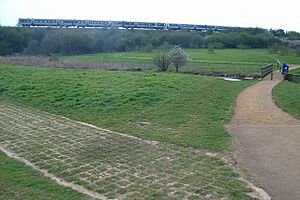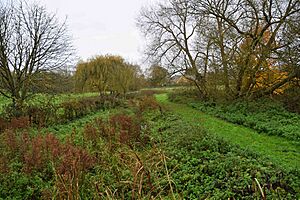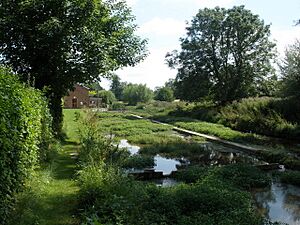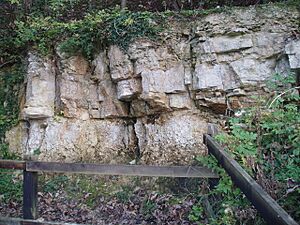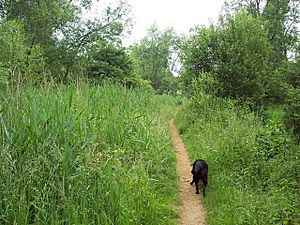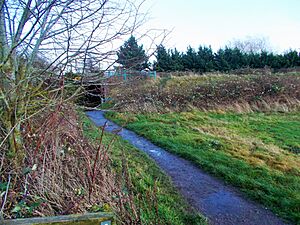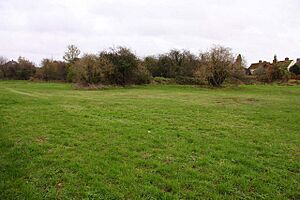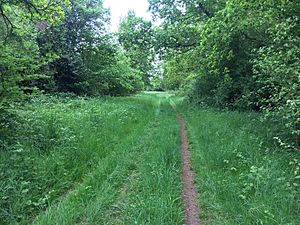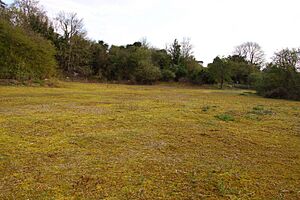List of local nature reserves in Oxfordshire facts for kids
Local Nature Reserves (LNRs) are special places in England where nature is protected. They are chosen by local councils because they have important plants, animals, or interesting rocks and land features. These councils make sure these areas are looked after, either by owning them, renting them, or working with the owners. They can even create special rules, called byelaws, to help protect these natural spots.
As of February 2020, there are fifteen Local Nature Reserves in Oxfordshire. This county is in South East England and is home to many different natural habitats.
Contents
- What are Local Nature Reserves?
- Discover Oxfordshire's Nature Reserves
- Adderbury Lakes: A Historic Landscape
- Bure Park: A Home for Newts
- Crecy Hill: A Hill of Wildflowers
- Cuttle Brook: A Diverse Waterway
- Ewelme Watercress Beds: A Spring-Fed Haven
- Kirtlington Quarry: A Window to the Jurassic Past
- Lye Valley: A Rare Wetland Habitat
- Mowbray Fields: Wildflowers and Orchids
- Rock Edge: Ancient Coral Reefs
- Saltway: A Path of Rare Plants
- Watlington Chalk Pit: Butterflies and Birds
- Other Important Nature Sites
- Images for kids
- See also
What are Local Nature Reserves?
Local Nature Reserves are areas that are important for nature in a local area. They are officially recognised by local councils. These places might have rare plants, unique animals, or special geological features like old quarries. The main goal is to protect these natural treasures for everyone to enjoy and learn from.
Local councils are responsible for looking after LNRs. They make sure these sites are managed well. This often involves working with local communities and wildlife groups. They can also set up rules to keep the areas safe and healthy for wildlife and visitors.
Discover Oxfordshire's Nature Reserves
Oxfordshire has many amazing Local Nature Reserves. Each one offers something unique, from ancient woodlands to special grasslands and historic sites. These places are perfect for exploring nature and learning about local wildlife.
Adderbury Lakes: A Historic Landscape
Adderbury Lakes are a beautiful example of a historic landscape. They were designed around 1768 by a famous landscape architect named Capability Brown. The reserve includes the lakes and the woods around them. It's a great place to see many different kinds of plants and animals.
Bure Park: A Home for Newts
Bure Park in Bicester is a lovely green space where the River Bure flows. The river feeds a pond that is home to great crested newts, which are special protected amphibians. The park has different habitats like grassy areas, bushy scrub, and woodlands, making it a diverse home for wildlife.
Crecy Hill: A Hill of Wildflowers
Crecy Hill is a steep, grassy hillside made of limestone. It's a type of habitat called calcareous grassland. This means the soil has lots of chalk or limestone, which helps many different wildflowers grow. More than 100 types of wildflowers and 15 kinds of grasses have been found here. It's also a haven for insects, including over 100 species, with 20 types of butterflies like the tiny small blue.
Cuttle Brook: A Diverse Waterway
Cuttle Brook is a nature reserve near Thame town centre. It has many different habitats, including the brook itself, bushy areas, woodlands, and open meadows. You can also find reed beds and sedge beds here, which are important for various wetland creatures. It's easy to access with seven entrances.
Ewelme Watercress Beds: A Spring-Fed Haven
The Ewelme Watercress Beds are former farms where watercress was grown. A stream runs through them, fed by a natural spring. This clear water creates a perfect home for wildlife like European water voles, which are small, shy mammals. Many different insects and plants also thrive in this watery environment.
Kirtlington Quarry: A Window to the Jurassic Past
Kirtlington Quarry is a disused quarry that is incredibly important for understanding Earth's history. It's one of only five sites in the world that shows evidence of mammals from the Middle Jurassic period! This means it's about 150 million years old. Scientists have found fossils of nine different early mammal species here. They've also found fossils of dinosaurs, crocodilians, pterosaurs (flying reptiles), fish, and many shark teeth. It's like a giant natural history book!
Lye Valley: A Rare Wetland Habitat
Lye Valley is a very special place because it has a rare habitat called a calcareous valley fen. This type of wetland is not common and is very important for nature. The Lye Brook drains the area. You can find many different mosses here, along with rare insects like the soldier fly and uncommon spiders.
Mowbray Fields: Wildflowers and Orchids
Mowbray Fields is a nature reserve next to the Hagbourne Brook. It features a beautiful wildflower meadow, an old railway embankment, a pond, and wetland areas. It's famous for its many common spotted and southern marsh orchids. Over 200 different kinds of insects have been recorded here, making it a buzzing place!
Rock Edge: Ancient Coral Reefs
Rock Edge is a fascinating site that shows limestone rich in coral, known as Coral rag. This rock was formed when the area was under a warm, shallow sea, much like the Bahama Banks are today. It's full of fossils from these ancient coral reefs. These rocks date back to the Upper Jurassic period, about 145 million years ago. It's like looking back in time to a prehistoric ocean!
Saltway: A Path of Rare Plants
Saltway is a section of an ancient track with special grassy edges and hedges. It's important because it has the largest known group of a very rare plant called downy woundwort in Britain. This plant is often found along old Roman roads and ancient tracks on chalky soils. Salt Way itself might even date back to the Roman period!
Watlington Chalk Pit: Butterflies and Birds
Watlington Chalk Pit is a site with beautiful chalk grassland and bushy areas. It's home to many different lichens, mosses, and liverworts. Over twenty types of butterflies have been seen here, fluttering among the flowers. In winter, you might spot birds like fieldfares, redwings, yellowhammers, and linnets.
Other Important Nature Sites
Some Local Nature Reserves also have other special designations, meaning they are recognised for even more important natural features.
- GCR = Geological Conservation Review site: These sites are important for studying the Earth's geology and history.
- SSSI = Site of Special Scientific Interest: These are areas that are important for their wildlife, geology, or landforms across the whole country.
Some LNRs in Oxfordshire that also have these special designations include:
- Kirtlington Quarry (GCR, SSSI)
- Lye Valley (SSSI)
- Magdalen Quarry (GCR, SSSI)
- Rock Edge (GCR, SSSI)
- Saltway (SSSI)
- Tuckmill Meadows (SSSI)
- Watlington Chalk Pit (SSSI)
Images for kids
See also
- List of Sites of Special Scientific Interest in Oxfordshire
- Berkshire, Buckinghamshire and Oxfordshire Wildlife Trust



